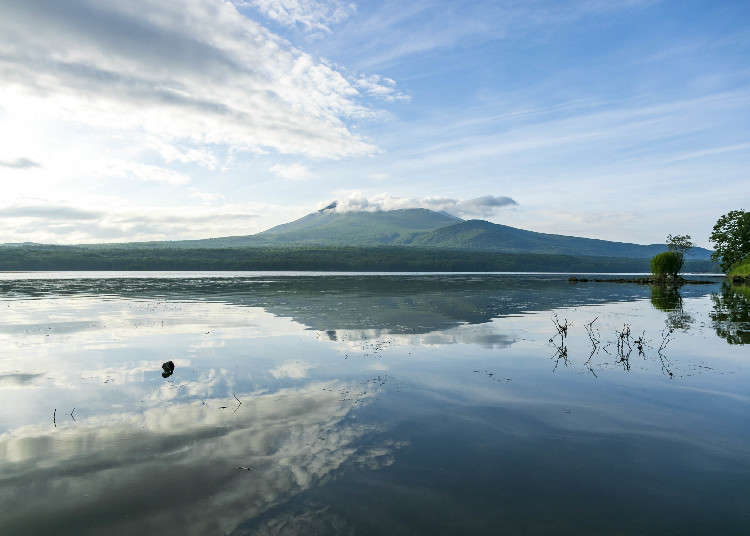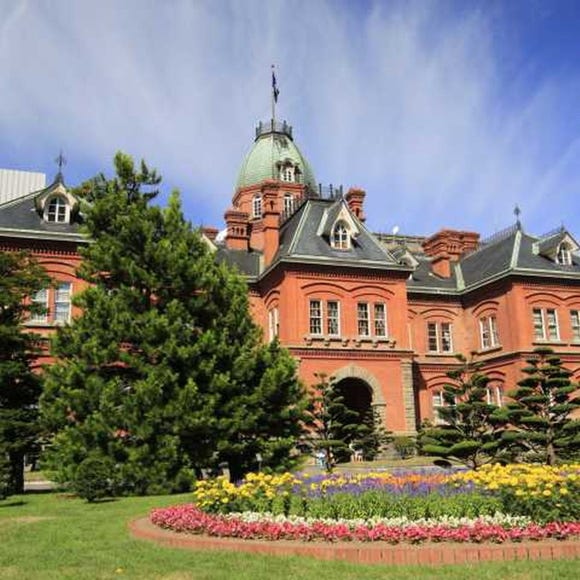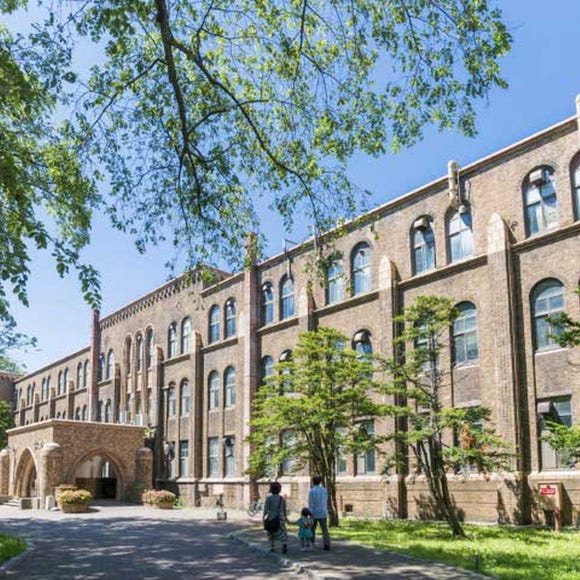
Enjoy Scenic Views and Outdoor Activities in Northern Japan! Top things to do in Onuma Quasi-National Park
- Written by: Minna no Kotoba Sha
Onuma Quasi-National Park, established in 1903 and located about 30 km north of Hakodate City in Hokkaido, is one of Japan's oldest nature parks. The park features the incredible active volcano, Mt. Komagatake, and the three lakes formed by past eruptions.
The entire area surrounding these lakes has been designated as a quasi-national park, offering visitors numerous scenic viewpoints and various outdoor activities. In this article, a local Hokkaido writer highlights some must-visit spots within the vast Onuma Quasi-National Park.
All About Onuma National Park

Onuma Quasi-National Park spans the three towns of Nanae, Shikabe, and Mori, covering a vast area of 9,083 hectares. Onuma originally took shape around 30,000 to 50,000 years ago with the eruption of Mt. Komagatake, with subsequent eruptions leading to the creation of three dammed lakes, Onuma, Konuma, and Junsainuma. The park's intricate shorelines and numerous small islets, also formed through volcanic activity, create a landscape reminiscent of a Japanese garden. The area also serves as a stopover for waterfowl, including swans, and became a designated wetland in 2012 through the Ramsar Convention.
Onuma has been regarded as a famous scenic spot since the Edo Period. It has even been recorded that Prince Heinrich of Germany visited the area in 1879, followed by Emperor Meiji in 1881, for the purpose of admiring its beauty. It was designated as a prefectural park in 1922, and as a quasi-national park in 1958. Recognized by the government as a center for international exchange, Onuma has played a role in showcasing its natural environment, culture, history, and industry to the world, offering a wide range of experiences and hands-on activities.
Getting to Onuma National Park
Access from Central Hakodate:
By Car:
Take National Route 5 (approx. 40 min)
From Hakodate Airport (approx. 30 min)
By Public Transportation:
JR Line:
Take Limited Express Hokuto (25 min) or local train (45 min) to Onuma Koen Station
By Bus
Ride Hakodate Bus (bound for Shikabe via Onuma Koen) from Hakodate Station to Onuma Koen Bus Stop (approx. 70 min)
Access from Sapporo:
By Car:
Take Hokkaido Expressway, Onuma-koen Interchange, or National Route 5 (approx. 3 hr. 30 min.)
By Public Transportation:
JR Line: Ride Limited Express Hokuto to Onuma Koen Station (approx. 3 hr. 20 min.)
Things to Do at Onuma Quasi-National Park
Take a Tour of the Islands

There are 126 islands scattered across the three lakes of Onuma, some of which are connected by bridges, allowing visitors to explore them on foot. There are two walking paths you can take from the park square. One is Oshima-no-michi (Oshima Trail, approx. 15 min.), which crosses two islands via Nishi-Oshima Bridge on the right, or the Shima Meguri-no-michi (Island-Hopping Trail, approx. 50 minutes), which crosses seven islands via Koraku Bridge on the left.

The Shima Meguri-no-michi (Island-Hopping Trail) is a lovely promenade of islets connected by arched bridges. In May, Ezo-yama Tsutsuji (Mountain azaleas) bloom along the path, while in July and August, water lilies and Kohone (Spatterdock) can be seen floating on the surface. During the fall, the trail offers stunning views of autumn foliage.
Cruise Around Onuma and Konuma

There’s also a sightseeing cruise that allows you to appreciate the beauty of Onuma Quasi-National Park from the water’s surface. Today’s adventure was a 30-minute sightseeing tour all around Lake Onuma and Konuma by boat!

First, head to the ticket booth on the right side of the plaza to purchase your ticket. Boats depart every 40 minutes between 9:00 a.m. and 4:20 p.m. during the regular operation period (May 1 to October 31). In April and November, boats run on an irregular schedule, so be sure to inquire at the ticket booth in advance.

Beside the ticket booth is a little shopping corner with goods like original blend drip coffee (220 yen per pack), so be sure to grab one as a keepsake of your boat ride!

The boats are sheltered, so participants can ride comfortably even on rainy days. Once it departs, your captain will provide insightful commentary on the scenic spots of the area (Japanese only) as you weaves through the islands toward the center of Lake Onuma.

There’s a small deck at the back of the boat where you can step outside to admire the scenery. Although the weather was overcast during our trip, Mt. Komagatake still made itself known from behind the clouds in all its majestic beauty!

About 15 minutes after leaving port you’ll come to Tsukimi Bridge, which separates Lake Onuma from Lake Konuma. Passing under this bridge takes you to Lake Konuma, and if your timing is on point, you may even catch a glimpse of the limited express train crossing the bridge against the Komagatake backdrop. Unfortunately on the day of this trip, we missed the train by just a few seconds—such a shame!
The Best Spot to View Mt. Komagatake
There are various photo spots where you can capture great shots of Mt. Komagatake both from on land and on the water’s surface.

On the Sightseeing Boat
About 10 minutes into the boat ride, the boat makes a turn around the center of Lake Onuma. With nothing to obstruct the view, you’ll get a clear view of Mt. Komagatake, seemingly floating on the lake itself!

Hakamagoshi Bridge
Hakamagoshi Bridge is the sixth bridge you’ll cross when walking the Island-Hopping Trail, with a wonderful view of Mt. Komagatake framed by the greenery of the islands.

Wakasagi Island
This small island is located right after the second bridge, Wakasagi Bridge, along the Island-Hopping Trail. From the north shore of the path, you’ll see a picture-perfect view of Mt. Komagatake towering in the background behind the floating islets.

Nishi-Oshima Island
This is the most easily accessible viewpoint. After crossing the first bridge of the Island-Hopping Trail, Nishi-Oshima Bridge, head down to the shore on your left for a stunning view of Mt. Komagatake right before your eyes!

Lakeside Wooden Path
A bit farther from the park’s center (about a 10-minute drive east) is a hidden gem of a viewpoint. Because it’s a bit of a walk from the parking lot, we recommend renting a bicycle for convenience. The entrance to the viewpoint is marked by the bicycle parking area (pictured in photo).

As its name suggests, the Lakeside Wooden Path is a wooden walkway stretching about 50 meters through the forest leading to the viewpoint. At first, the view of the lake is hidden by the trees. However…

…there’s a magnificent, unobstructed view of Mt. Komagatake awaiting just at the end! The eastern side of the lake sees little boat traffic, so it tends to be quiet and calm, making it the perfect surface to reflect the mountain, just like a mirror!
Onuma Quasi-National Park is so vast, it’s impossible to cover all the viewpoints on foot. So we recommend rental bicycles or Segway tours to explore even more of these beautiful, scenic spots.
Canoeing Experience

You can also enjoy a canoeing experience on both Lake Onuma and Konuma. Feel the breeze as you paddle across the water, see the plants and waterfowl, and pass through the islands not connected by bridges. Canoeing tours are also available, with instructions provided so that even beginners and first-timers can join with confidence!
See Stunning Sunsets Along Sunset Road

On the western side of Lake Onuma is Lake Konuma, which happens to have its own beautiful sunset viewing spot. You can get there by following the path called Yuuhi-no-michi (Sunset Path), just a quick 2-3 minute walk from the parking lot after crossing the train tracks. The forest surrounding the path is quite dense, so we recommend sneakers and long sleeves, even during the summer season.

A 4-5 minute walk from the entrance of the walking trail will take you right to the sunset viewpoint. The direction of the setting sun will vary by season, but don’t worry! You can easily go down to the lakeshore, so you should be able to find a good vantage point. But since the sun sets behind the mountains across the lake, we recommend getting there a bit earlier than the predicted sunset time to make sure you catch the best view.

Along Sunset Path is a thriving population of water lilies. Amongst the white and pink flowers, you may even spot the rare yellow water lilies! They typically bloom from late June to late August, with mid-to-late July being peak season.

You’ll also find benches here and there along Sunset Path, also positioned amongst scenic spots. You can use the benches as landmarks to find the best viewpoints!
Experience the Best of Every Season

Onuma Quasi-National Park offers different attractions in every season. Spring marks the start of a variety of activities, as well as the season for flowers. The park's azaleas, planted throughout the grounds, start blooming in mid-May and typically reach peak in late May. It’s a stunning scenery of reds and greens that’s truly a sight to behold!

The Onuma Lakeside Festival takes place in the summer during the last weekend of July when water lilies are in full bloom. Boasting over a century of history, this event began in 1906 as a memorial service for those lost to past flooding disasters. Even to this day, a memorial service and lantern floating ceremony are held on the first day of the festival in their honor. The sight of these countless lanterns floating peacefully on the water at dusk is both somber and magical. But the festival also features other fun, crowd-drawing events, including live music, street performances, fireworks, and more.

Autumn is when Onuma Quasi-National Park reaches peak beauty, with Mt. Komagatake and the lakeside dyed in shades of gold and crimson. Maple, beech, and oak trees show off their brilliant red hues, and can be seen from mid-October to early November. It's also a great time for a scenic drive around the area!

Being relatively shallow, with a max depth of about 12 meters, the three lakes of Onuma begin to freeze over by late December. By January, the ice is thick enough to walk right on top of it!
The annual Onuma Hakodate Snow and Ice Festival, held during the first weekend of February, features ice-themed attractions, including large slides made from natural ice cut from the lake, along with some mind-blowing ice sculptures!
At the narrow border between Lake Onuma and Lake Konuma—a spot known as Hakuchodai Sebatto (Swan Resting Spot)—is one part that rarely freezes over, even in winter. This has made it a popular resting place for migratory birds, including whooper swans and ducks, making it a must-visit spot for birdwatchers.
Fun Awaits, Even in Winter!

Winter brings exciting seasonal activities to the frozen surface of the three lakes of Onuma, from snowmobiling and banana boating to more relaxed options like snowshoeing and nature observation tours. No matter what your preference, there’s plenty of ways to enjoy the ice and snow of Onuma!

Winter also brings with it a number of tasty experiences, as well! Before the lakes freeze in December, you can fish for wakasagi (Japanese smelt) from the pier, or you can wait until they’ve frozen over to try ice fishing. Any equipment you need is available for rent. All you need to do is arrive warmly dressed! For an additional fee, you can even cook and enjoy your catch right there as tempura or karaage.
When participating in winter activities, be sure to wear waterproof, insulated clothing like ski wear, and equip yourself with non-slip snow boots to prevent falls.
-

-
Address
Onumacho, Nanae-cho, Kameda-gun, Hokkaido, 041-1354
View Map -
Nearest Station
Onumakoen Station (Hakodate Main Line)
- Phone Number 0138-67-2170
-
Address
Onumacho, Nanae-cho, Kameda-gun, Hokkaido, 041-1354
- Tel: 0138-65-2517 (Nanae Town Hall, Division of Commerce, Industry, Labor and Tourism)
- Hours: Open 24/7
- Admission: Free (Fees apply for sightseeing boats & various activities)
- Closed: None
Making the Most of the Onuma Area
The area between Onuma Park Station and Onuma Park Square is lined with souvenir shops and eateries, with lots of local specialties to try such as Hakodate Onuma Beef and the local craft brew, Onuma Beer. Another longtime favorite is Onuma Dango, a unique treat of bite-sized dumplings made of azuki red bean, sesame, and mitarashi, and arranged to appear as if they are floating in the lake. It's a favorite treat for both tourists and locals alike!

Can’t decide where to go first? Check out the Onuma International Exchange Plaza (Onuma Tourist Information Center) next to the station. Here you’ll find brochures in different languages, including English and Chinese, as well as a free rest area where you can sit and plan your trip before heading out.

Inside Onuma International Exchange Plaza are more souvenirs and local products for sale. Around September, Nanae Town enters apple season, and as Japan’s birthplace of Western apple cultivation, continues to grow a variety of apples to this day. If you stop by, be sure to give some of their prized apples a try!
Your Perfect Base for Exploring Southern Hokkaido: Something to Do with Every Visit
In 1916, Onuma Quasi-National Park was voted one of Japan’s New Nihon Sankei (Three Scenic Views) in a travel guidebook, a testament to its long-standing, stunning landscapes. That beauty remains to this day, and as you walk through the park, you’ll be sure to encounter landscapes that captivate at every turn.
Whether cruising the lake by boat, driving or cycling through dense forests, or having fun in the winter snow and ice, Onuma offers a wide variety of activities, all in one spot, making it a truly unique destination for Hokkaido. For over 100 years, Onuma has been a true natural resort in the truest sense of the word.
Onuma also serves as a major transportation hub, with the Onuma Interchange as a gateway from various parts of Hokkaido to the Donan area. Going south brings you to Hakodate. Heading east takes you to the Minami-kayabe area, home to a number of Jomon Period World Heritage Sites. And up north you’ll find the towns of Mori and Yakumo, known for their seafood. National Route 227, leading to the Hiyama area (including Esashi Town, home of Hokkaido’s oldest festival), is also easily accessible.
There are also plenty of hotels and other accommodations nearby, making Onuma is the perfect place for overnight stays, too. So next time you plan a trip to Hokkaido, don’t be too quick to assume that your only option for a travel base is Hakodate. Instead, consider making Onuma your home base for exploring what the region has to offer!
Photography by Shuichi Miyazawa / Written and edited by Minna no Kotoba-sha
English translation by: Krys Suzuki
Minna no Kotoba Sha is a production company founded by an editor with extensive experience in editing local magazines in Sapporo. For over 20 years, our team has conducted research and written articles across Hokkaido, with Sapporo as our primary hub. Our diverse portfolio includes the production of various books such as travel guides, informational magazines, and collections showcasing the picturesque landscapes of Hokkaido. Comprised entirely of women, the team at Minna no Kotoba Sha boasts diverse interests, including a passion for travel, culinary delights, and alcoholic beverages. The scope of our communication efforts spans a wide range, covering everything from introducing notable restaurants to providing coverage of local events and sharing stories of leisure experiences.
*Prices and options mentioned are subject to change.
*Unless stated otherwise, all prices include tax.
Recommended places for you
-
Appealing

Otaru Canal
Rivers, Lakes & Canyons
Otaru
-

Former Hokkaido Government Office Building (Red Brick Office)
Other Historic Sites
Sapporo / Chitose
-
Appealing

Rukku and Uohei
Izakaya
Sapporo / Chitose
-
Appealing

Odori Park
Parks
Sapporo / Chitose
-

Niseko Village Ski Resort
Skiing & Snowboarding
Niseko / Rusutsu
-

Hokkaido University
Other Architecture
Sapporo / Chitose
-

Scenic Road Trip from Hakodate to Matsumae: Stunning Views, Traditions, and Tasty Delights
by: Nobuka Kawashima
-

Step into History at the Ofune World Heritage Site: Explore Hokkaido's Jomon Culture
-

Touch the Sky: Enjoy Seasonal Escapes on the Asahidake Ropeway (Hokkaido)
-

A Tour of Niseko Distillery: Exploring the World of Japanese Whiskey and Craft Gin
-

Don’t Miss These 5 Popular Local Hokkaido Chain Restaurants - For Onigiri, Curry & More
by: Nobuka Kawashima
-

Enjoy Autumn Hues in Japan's Wild Frontier: Two-Day Road Trip Itinerary for Mount Daisetsu and Asahikawa (Hokkaido)
by: Hide
-

Never Knew About This Place! Foreign Residents Share 10 Memorable Spots in Sapporo
-

Noboribetsu Onsen: 5 Best Things to Do in Japan's Famous Hot Springs Town!
-

Secrets to Shopping in Japan: Guide to Annual Sales in Japan & Where to Shop
by: Miyu Shimada
-

Daisetsuzan National Park (Hokkaido) - Seasonal Guide to the Playground of the Gods
-

Guide to Central Sapporo: Highlights Of Odori Park & Sapporo TV Tower
-

Japan's Fascinating Moerenuma Park: Isamu Noguchi's Stunning Living Sculpture
- #best sushi hokkaido
- #things to do hokkaido
- #best ramen sapporo
- #what to bring to japan
- #new years in tokyo
- #what to buy in ameyoko
- #japanese nail trends
- #what to do in odaiba
- #onsen tattoo friendly tokyo
- #daiso
- #best sweets otaru
- #japanese fashion culture
- #best nature furano
- #japanese convenience store snacks
- #best japanese soft drinks





















